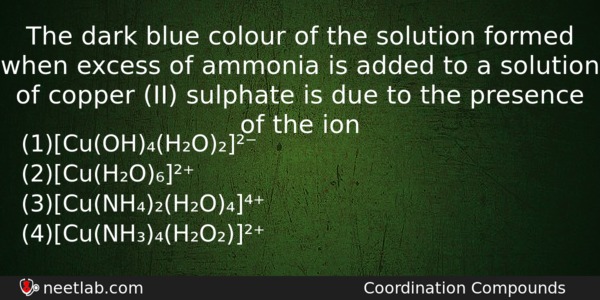| ⇦ | 
| ⇨ |
The dark blue colour of the solution formed when excess of ammonia is added to a solution of copper (II) sulphate is due to the presence of the ion
Options
(a) [Cu(OH)₄(H₂O)₂]²⁻
(b) [Cu(H₂O)₆]²⁺
(c) [Cu(NH₄)₂(H₂O)₄]⁴⁺
(d) [Cu(NH₃)₄(H₂O₂)]²⁺
Correct Answer:
[Cu(NH₃)₄(H₂O₂)]²⁺
Explanation:
when excess of ammonia is added to a solution of copper (II) sulphate, then the complex compound, [Cu(NH₃)₄(H₂O₂)]SO₄ is formed which causes the formation of deep blue colour.
Related Questions: - Which of the following is the IUPAC name of the compound
- The inert form of carbon is
- The density of air is 0.001293 g/cc at STP. Its vapour density is
- Mutarotation does not occur in
- Which of the following species contains equal number of σ- and π-bonds
Topics: Coordination Compounds
(87)
Subject: Chemistry
(2512)
Important MCQs Based on Medical Entrance Examinations To Improve Your NEET Score
- Which of the following is the IUPAC name of the compound
- The inert form of carbon is
- The density of air is 0.001293 g/cc at STP. Its vapour density is
- Mutarotation does not occur in
- Which of the following species contains equal number of σ- and π-bonds
Topics: Coordination Compounds (87)
Subject: Chemistry (2512)
Important MCQs Based on Medical Entrance Examinations To Improve Your NEET Score
18000+ students are using NEETLab to improve their score. What about you?
Solve Previous Year MCQs, Mock Tests, Topicwise Practice Tests, Identify Weak Topics, Formula Flash cards and much more is available in NEETLab Android App to improve your NEET score.
Share this page with your friends

Leave a Reply